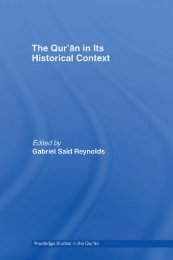Download (1 MB) - Islam and Christian-Muslim Relations: Articles ...
Download (1 MB) - Islam and Christian-Muslim Relations: Articles ...
Download (1 MB) - Islam and Christian-Muslim Relations: Articles ...
You also want an ePaper? Increase the reach of your titles
YUMPU automatically turns print PDFs into web optimized ePapers that Google loves.
116 CHAPTER 5path of drastically redefining their role as one of active social <strong>and</strong> politicalengagement, a role that was a conscious departure from the accommodationiststance of the elder Shi‘i mujtahids. 26 Al-Husayni stayed in Najaffor six years, <strong>and</strong> came into contact there with, among others, Khumayni.27 That he was influenced by some of the implications of whatChibli Mallat has characterized as the “Renaissance” of the 1960s 28 isbest attested perhaps by his being expelled from Najaf by the Iraqi authoritiesfor political involvements (of which no details are known, however).29 Al-Husayni later went to Iran <strong>and</strong> spent another four years inQumm, which, like Najaf, was a major center not only of learning butalso of Shi‘i political opposition. 30 He returned to Pakistan in 1978, onthe eve of the revolution in Iran. Involved in the political mobilization ofthe Shi‘a from the start, <strong>and</strong> with such impeccable credentials as studyingat the premier institutions of Najaf <strong>and</strong> Qumm <strong>and</strong>, not least, countingKhumayni as a mentor, he was soon prominent enough to succeed Ja‘farHusayn as the leader of the TNFJ in 1983. He led the Shi‘a through 1988,in which year he was assassinated. 31The manifesto of the TNFJ, formally issued in 1987, is a document ofconsiderable interest <strong>and</strong> deserves brief consideration here. 32 It prescribesthe Qur’an <strong>and</strong> the sunna as the fundamental sources of Pakistan’s Constitution<strong>and</strong> of all laws, but lays down that each “recognized” <strong>Islam</strong>icschool of thought or sect is to be governed by its own interpretation ofwhat the Qur’an <strong>and</strong> the sunna mean. 33 All sects are to be given “effective”representation on the Council of <strong>Islam</strong>ic Ideology, a body chargedby the Constitution of Pakistan with the function of advising the governmenton all matters pertaining to <strong>Islam</strong> in public life. 34 The dem<strong>and</strong> forreligious freedom figures prominently, <strong>and</strong> it is stated to include the rightto the unhindered observance of Muharram as well as the right to proselytizefor one’s faith. 35 There is no dearth of rhetoric on the need for acomplete overhauling of Pakistan’s economic, social, <strong>and</strong> political systems;<strong>and</strong> the lack of true commitment to <strong>Islam</strong> on the part of the rulingelite <strong>and</strong> the state’s subservience to the “imperialist powers” are amongthe factors the manifesto emphasizes as the causes of Pakistan’s problems.Finally, a significant aspect of the TNFJ’s proposed mechanism for changeis to create a “Popular <strong>Islam</strong>ic Army”: based on compulsory militarytraining for all able-bodied males, this army is seen as helping to reducethe distance between the military <strong>and</strong> the people (the military regime ofGeneral Zia ul-Haqq was still in power in 1987) <strong>and</strong> as reviving the spiritof holy war. 36The emergence of a noisy Shi‘i organization in Pakistan in the wake ofthe Iranian revolution caused considerable consternation to many Sunnis.Though the manifesto of the TNFJ was not explicitly sectarian, it is notdifficult to visualize how many a wary Sunni interpreted it. That <strong>Islam</strong>



